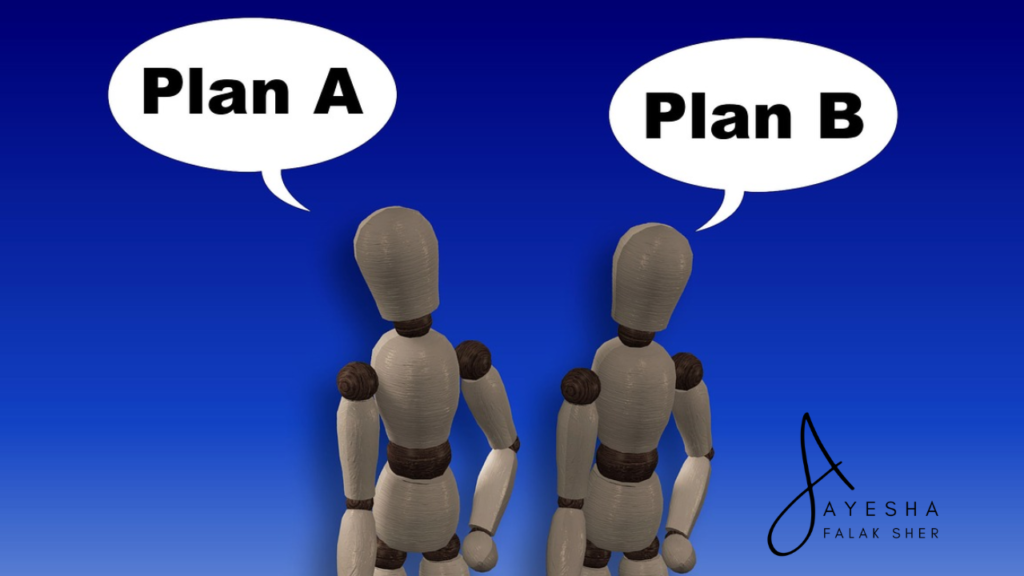Have you considered what may happen if your main plans don’t work out?
That’s when you start thinking about having a backup plan, often called Plan B.
Having a Plan B can help you when things go wrong unexpectedly.
Basically, Plan B is like a second plan we make to deal with problems and keep on track when our first plan doesn’t go as expected.
In this article, we will talk about why it’s important to have a backup plan and how it can make us better prepared and stronger.
We’ll look at how Plan A and Plan B work together and see how having a backup plan can make it more likely for us to achieve our main goals.
Let’s explore why Plan B is important for keeping us on the right path, even when life throws us curveballs.
Let’s see.
Table of Contents
ToggleThe Nature of Plan A
Plan A is like your main roadmap, guiding you towards your goals and dreams.
It’s the first plan you come up with, the one you hope will lead you straight to success.
Plan A is your primary strategy for achieving your goals.
It’s the initial plan you make, usually based on careful thought and consideration.
This plan lays out the steps you need to take to reach your desired outcome.
5 Benefits of Having Only Plan A:
- Clarity: Having a single plan can make things clear and straightforward. You know exactly what you need to do to achieve your goals.
- Focus: With only one plan to follow, you can concentrate all your efforts and resources towards making it work.
- Efficiency: Having just one plan can streamline your actions, making you more efficient in pursuing your objectives.
- Confidence: Knowing you have a solid plan can boost your confidence and motivation to succeed.
- Commitment: Relying solely on Plan A shows your commitment to your goals, as you put all your energy into making it a reality.
5 Common Pitfalls of Relying Solely on Plan A:
- Rigidity: Being too attached to Plan A can make you resistant to change, hindering your ability to adapt to unexpected circumstances.
- Vulnerability: Depending solely on one plan leaves you vulnerable to failure if things don’t go as expected.
- Limited Perspective: Focusing only on Plan A can narrow our vision, causing you to overlook alternative solutions or opportunities.
- Overconfidence: Believing too strongly in the success of Plan A can lead to complacency and a lack of preparedness for potential setbacks.
- Stress and Pressure: The pressure to make Plan A work can be overwhelming, leading to increased stress and anxiety.
Real-life Examples of Plan A Failures:
Example 1:
tennis player Serena Williams experienced a setback when her Plan A, which involved winning the Grand Slam tournaments, faced unexpected challenges due to injuries and tough competitors.
Despite her determination and talent, relying solely on this plan proved insufficient to guarantee success in every tournament.
Example 2:
Similarly, sprinter Usain Bolt, known for his remarkable speed and dominance in track and field, encountered difficulties when his Plan A, centered around breaking world records and winning gold medals, was disrupted by injuries and aging.
Despite his extraordinary abilities, relying solely on Plan A without considering potential setbacks led to unexpected hurdles in his career.
These examples highlight how even the most talented athletes can face setbacks when relying solely on Plan A, emphasizing the importance of flexibility and preparedness in achieving long-term success.
5 Reasons Why Do You Need Plan B?

When it comes to planning, having a backup plan, or Plan B, is super important. Let’s dig into why you need it.
1. Anticipation of Uncertainty:
Life can be unpredictable.
You never know what might happen next.
That’s where Plan B comes in handy.
It helps you prepare for unexpected twists and turns.
Having a backup plan ready lets you stay calm and focused even when things don’t go as planned.
It’s like having an umbrella for a rainy day – you might not need it all the time, but it’s there just in case.
2. Flexibility and Adaptability:
Being able to adapt to changes is a valuable skill.
With Plan B, you’re not stuck with just one way of doing things.
Instead, you’re flexible and open to trying different approaches if Plan A doesn’t work out.
This flexibility allows you to adjust your strategies according to the situation, increasing your chances of success.
Remember, it’s not about giving up on Plan A; it’s about being smart and prepared for whatever comes your way.
3. Mitigating Risks and Contingencies:
Life is full of risks, big and small.
Plan B helps you identify and minimize these risks.
It’s like wearing a seatbelt while driving – you hope you won’t need it, but it’s there to keep you safe in case of an accident.
By having a backup plan in place, you’re taking proactive steps to reduce the impact of potential setbacks.
This proactive approach safeguards your goals and gives you peace of mind, knowing you’re prepared for any challenges.
4. Building Resilience and Confidence:
Facing setbacks can be tough, but having a Plan B can help you bounce back stronger.
Knowing you have a backup plan makes you less afraid of failure.
Instead, you see it as an opportunity to learn and grow.
This resilience builds your confidence, making you more willing to take risks and pursue your dreams.
With Plan B by your side, you’re ready to tackle whatever obstacles come your way, knowing you have what it takes to overcome them.
5. Enhancing Decision-Making:
Having a Plan B provides a safety net and enhances your decision-making process.
When you know you have a backup plan, you can make choices more confidently, knowing that you have options if things don’t go as planned.
This confidence allows you to make bolder decisions and pursue opportunities you might otherwise hesitate to take.
Additionally, knowing that you have a backup plan can alleviate the pressure of making the “perfect” decision, freeing you to focus on taking action and moving forward. Top of Form
The Relationship between Plan A and Plan B

In your way to achieve your goals, both Plan A and Plan B play important roles.
Think of them as partners, each bringing something valuable to the table.
Let’s explore how they work together:
1. Complementary Roles and Interdependence:
Plan A and Plan B are like two sides of the same coin.
While Plan A is your primary strategy, Plan B serves as a backup in case things don’t go as planned.
They complement each other by covering different scenarios.
For example, Plan A might focus on your ideal path to success, while Plan B prepares you for unexpected obstacles along the way.
They depend on each other to ensure you’re ready for whatever comes your way.
2. How Plan B Strengthens Plan A:
Having a Plan B doesn’t mean you doubt the success of Plan A.
Instead, it strengthens it.
Knowing you have a backup plan in place can give you the confidence to pursue your primary strategy wholeheartedly.
It’s like having a safety net – knowing it’s there can make you more willing to take risks and push forward with Plan A.
Plus, the preparation involved in creating Plan B can help you identify weaknesses in Plan A and make improvements.
3. Ensuring Alignment and Consistency:
For both plans to be effective, they need to work together seamlessly.
This means ensuring that Plan B is aligned with the goals and strategies of Plan A. They should support each other and not contradict one another.
Consistency is key – you don’t want your backup plan to lead you in a completely different direction than your main plan.
By ensuring alignment and consistency between the two, you can maintain clarity and focus on your objectives.
4. Flexibility and Adaptability:
One of the key relationships between Plan A and Plan B lies in their ability to promote flexibility and adaptability.
While Plan A sets a clear path towards your goals, Plan B allows you to adjust and pivot when circumstances change.
This dynamic duo empowers you to respond to unexpected challenges with agility, ensuring you can still progress towards your objectives even in the face of adversity.
By embracing both plans, you cultivate a mindset of resilience and openness to change, maximizing your ability to navigate uncertain terrain.
5. Risk Mitigation and Contingency Planning:
Another crucial relationship between Plan A and B revolves around risk mitigation and contingency planning.
Plan A focuses on achieving optimal outcomes but is not immune to potential risks and setbacks.
That’s where Plan B steps in as a strategic safety net, ready to deploy when Plan A encounters obstacles beyond your control.
By proactively identifying potential risks and developing contingency measures in Plan B, you minimize the impact of adverse events on your overall progress.
This integrated approach to risk management ensures that you’re well-prepared to handle whatever challenges may arise, increasing the likelihood of success in your endeavors.
By understanding their complementary roles, you can confidently navigate challenges and increase your chances of achieving your goals.
So, don’t hesitate to make both Plan A and Plan B as you pursue your dreams.
How to Implement Plan B Strategies?
When it comes to implementing Plan B strategies, there are five key steps you can take to make sure you’re prepared for any unexpected challenges that may come your way.
1. Identifying Potential Failure Points
Firstly, it’s important to identify potential failure points.
This means thinking about where your original plan might go wrong.
Maybe certain steps are more risky or areas where things could easily go off track.
By recognizing these potential failure points, you can come up with solutions to address them before they become bigger problems.
2. Developing Alternative Courses of Action
Next, you’ll want to develop alternative courses of action.
This means thinking about different ways to approach your goal if your original plan doesn’t work out.
It’s important to be flexible and open-minded, considering various options that could still lead you to success even if things don’t go as planned.
3. Evaluating Feasibility and Effectiveness
Once you’ve brainstormed some alternative courses of action, it’s time to evaluate their feasibility and effectiveness.
This means thinking about whether each alternative is realistic and achievable given your resources, skills, and the circumstances you’re facing.
You’ll also want to consider how likely each alternative is actually to help you achieve your goal.
4. Most Promising Alternative Course of Action
After evaluating your options, you can choose the alternative course of action that seems most promising and start putting it into practice.
This might involve making adjustments to your original plan or completely changing direction depending on what makes the most sense given the situation.
5. Monitor Your Progress
Finally, it’s important to monitor your progress and be prepared to adapt your Plan B strategy as needed.
Keep an eye on how things are going and be willing to make changes if you encounter new challenges or opportunities along the way.
By following these five strategies for implementing Plan B, you can increase your chances of success even when things don’t go according to plan.
Remember, being prepared and flexible is key to overcoming obstacles and achieving your goals in the face of uncertainty.
Case Studies: Plan A vs. Plan B
In different parts of life, having a backup plan, or Plan B, can really make a difference.
Let’s look at some examples to understand this better:
Business and Entrepreneurship:
In business, having a Plan B is super important.
Imagine you start a company and have a big goal to reach. That’s your Plan A. But what if things don’t go as planned?
Maybe the market changes, or there’s unexpected competition.
This is where Plan B comes in handy.
It could be having different products to offer or changing your marketing strategy.
For example, you might also sell sunglasses if you’re selling umbrellas and it’s not raining as much.
This way, you’re ready for whatever comes your way and can still succeed even if your original plan doesn’t work out.
Personal Development and Career Planning:
In your personal life and career, having a backup plan is just as important.
Let’s say you have a dream job in mind, and you’re working hard to achieve it.
That’s your Plan A. But sometimes, things don’t go smoothly.
You might not get the job you wanted, or you might realize it’s not what you thought it would be.
This is where having a Plan B can help you stay on track.
Maybe you’ll consider other job options or think about furthering your education.
Having alternatives ready can help you keep moving forward and find success in different ways.
Emergency Preparedness and Crisis Management:
When it comes to emergencies or crises, having a backup plan can be a lifesaver.
You never know when something unexpected might happen—a natural disaster, a medical emergency, or a sudden loss of income.
Having a Plan B means being prepared for these situations.
It could be having an emergency savings fund, knowing where to go in case of an evacuation, or having a backup communication plan with your family.
By thinking ahead and having a backup plan, you can minimize the impact of emergencies and keep yourself and your loved ones safe.
Summing Up!
A backup plan, or Plan B, is important in life.
It’s like having a safety net that helps you when things don’t go as planned with your main goal, or Plan A.
Whether in business, working on personal goals, or facing emergencies, having a Plan B can make a big difference.
It gives you options and helps you stay on track even when facing challenges.
By being prepared and flexible, you can increase your chances of success and overcome obstacles that might come your way.
So remember, having a Plan B isn’t just a good idea—it’s a smart strategy for safeguarding your success in Plan A.
Do you want captivating content that grabs attention and shares your story? Well, you’re in luck.
I’m an experienced SEO content writer who is here to turn your ideas into impactful words that people will remember.
Let’s team up to bring your message to the forefront. I’ve got you covered whether you need engaging blog posts, informative articles, or convincing marketing material.
Your voice is special, and it deserves to be heard. I’m ready to help you make that a reality.
Get in touch with me today to make your brand or message shine now.









